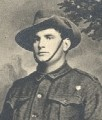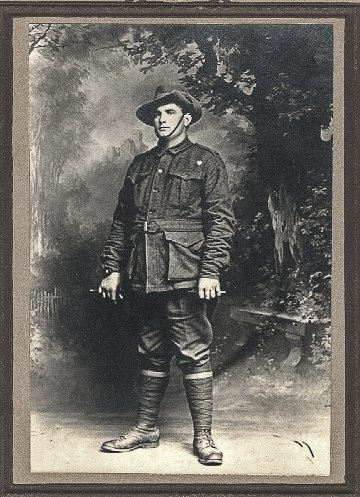Lemuel Reginald BATEY
Eyes brown, Hair curly dark brown, Complexion fresh
Lemuel Batey – still missing
DNA donors are still needed for Lemuel Batey (see DNA panel at end of story). His name appears in a list of nine soldiers that an eyewitness (Corporal Frederick Webster) reported as seeing buried together after being killed on 19 July 1916 during the Battle of Fromelles.
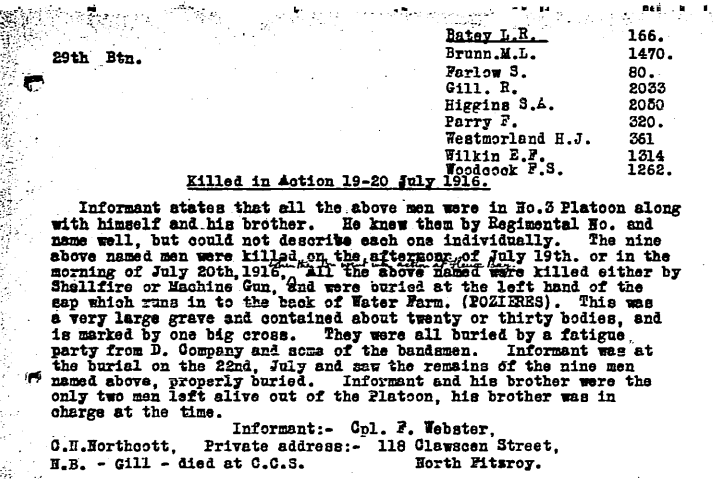
The sap (a short covered trench / tunnel) is probably on the Mine Ave end of the trench (marked in blue in the map below) near where the “water farm” is marked.
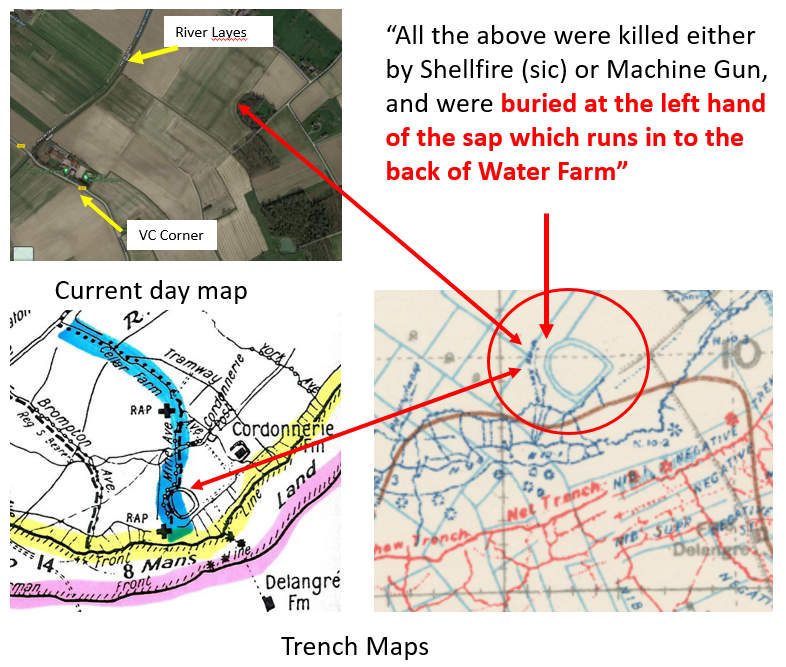
The above statement cannot be confirmed in total. But individual soldiers mentioned in the list of nine were recovered by the German Army, buried in the mass graves and, post-2009, identified by DNA and re-interred at the Pheasant Wood cemetery at Fromelles. This increases the possibility that Lemuel Batey may also be one of those buried at Fromelles.
There are also similar notes in these soldiers’ AIF files that they are buried at Fleurbaix, and a general map reference, sheet 36, with the exception being Private Robert Gill who died at the casualty clearing station and is buried at the Bailleul Communal Cemetery Extension.
It would have been chaos in the trenches during the battle and in the immediate aftermath, and it is no wonder records of deaths and burials are often non-existent or contradictory. There are no records of these soldiers being found in this vicinity. However, in 2008 a burial ground was located at Pheasant Wood behind the old German front line at Fromelles that contained the bodies of 250 British and Australian soldiers.
Many of their identities, including Fred, were confirmed through a combination of anthropological, archaeological, historical and DNA techniques.
To date (2024), DNA testing has been able to identify 180 of these 250 soldiers.
Despite being identified as being buried in the sap, four of these nine men - Ernest Wilkin, Frederick Parry, Samuel Farlow and Norman Brumm – were identified in 2010 as being buried in the Pheasant Wood Cemetery! Was the original grave disturbed by shelling or otherwise re-opened necessitating re-burial by the Germans?
With four already identified, are the remaining four (Herbert Westmoreland, Francis Woodcock, Lemuel Batey and James Higgins) still amongst those soldiers now buried at the Pheasant Wood cemetery but unidentified?
Lemuel Batey
Lemuel Reginald Valentine Fitzhawthorn Batey was born on 11 February 1895 to Thomas Place Batey and Eliza Ann Ford. He was the ninth of ten children. One daughter died in infancy leaving Lemuel to grow up with six older brothers, one older sister (Laura) and one younger sister (Camelia known as Kate).

Back (standing L-R) Martin (Nuck) 1878-1948, Edward (Harry) 1882-1949, Francis 1884-1951
Front (seated L-R) Thomas snr 1845-1902, Eliza 1855-1921, Thomas jnr 1880-1940
Front (children standing L-R) George (Jack) 1890-1920, Camelia (Kate) 1897-1977, Isaac (Ike) 1893-1974, Laura 1888-1975, Lemuel (Lem) 1895-1916
Lemuel’s father, Thomas snr, died suddenly in August 1902 at the age of 56 leaving 46-year-old Eliza widowed with nine children aged 5 to 24. Lemuel was just 7.
Lem’s older sister, Laura, was to be a faithful and undaunted correspondent writing to the Red Cross in Australia and internationally in the search for Lemuel, commencing as soon as they were notified he was missing in August 1916. At the time, she was 28 years old and not yet married, being the helper to her 60-year-old widowed mother. Her brothers ranged in age from Lemuel at 21 to Martin at 38 while the youngest girl was just 19.
The call to duty was a serious one….
Under 21 years of age when he enlisted in July 1915, Lem needed his mother’s consent – which she willingly gave. To provide extra gravitas, she had her written consent witnessed by a local J.P.
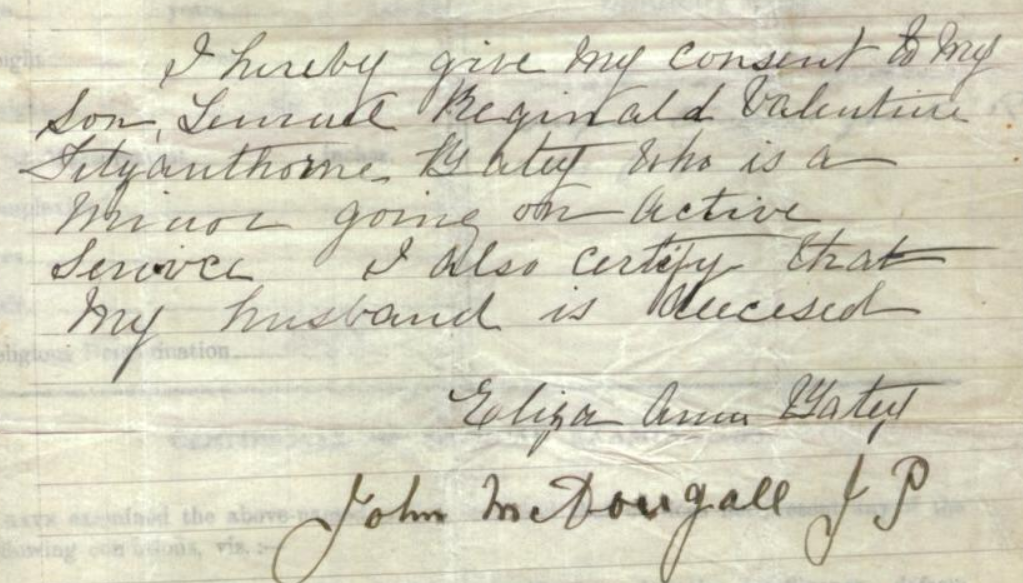

With many other young recruits, Lem went in to training at Broadmeadows camp and was assigned to the 29th Battalion, A company.
Prior to leaving Australia, Lem returned home to Katandra for his final leave. His many friends gathered on 20 October 1915 to say farewell and to present Lem with some tokens of esteem – a pair of inscribed military brushes and a gold-mounted fountain pen. In response to his many well-wishers, Lem responded in ‘a very manly spirit’ saying:
“He knew he was leaving good friends, but the call to duty was a serious one.”
29th Battalion embarked for Egypt and France
Lem left Australia on board HMAT A11 Ascanius on 10 November 1915 with the newly formed 29th Battalion, a part of the 8th Brigade. They arrived in Suez, Egypt on 7 December and training and defence of the Suez Canal continued with postings at Ismailia, Tel el Kebir, Ferry Post and Moascar. While in Tel el Kebir in March, the troops were reviewed by the Prince of Wales.
In total, Lem spent six months in Egypt and, from his AIF record, it seems that he was fortunate to remain in good health avoiding many of the illnesses – including mumps, measles and influenza – that regularly impacted the training camps.
The call to the Western front came in mid-June. They boarded the troop ship Tunisian in Alexandria, heading to Marseilles, arriving there on 23 June 1916. Their arrival was well received as Private James Lang (858) of Glengarry, Victoria wrote:
“The French people lined the streets to see us, and gave us a great welcome. Lots of poor woman and young girls started crying. No doubt the poor things were thinking of their own dear ones who had gone to the front.”
The 29th took the train to Hazebrouck and on to Steenbeque and by June 26th they were encamped in Morbeque, about 30 kilometres from Fleurbaix. On 1 July they moved to Hazebrouck where training included the use of gas masks for the possible use of “lachrymatory shells” – tear gas. Training was tough. One day included a march of 16 miles carrying 75 pounds of kit, which only the youngest and fittest could complete.
On July 9th they moved to Erquingham, just outside of Fleurbaix and on the 10th they got their first experience in the frontline trenches.
They were back in Fleurbaix on the 14th and on 19 July, Lem was in the trenches by 8pm with his comrades in D and A companies, ready for the attack. Many of the men broke through the forward lines of German trenches looking for what they had been told was a second line. Instead, all they found were a series of shallow drainage ditches.
At 2 am the German counterattack began, but as noted in the War Diaries, “After a struggle, Germans content to stop at their own trench.”
The attack on their right was altered and Lem’s unit became exposed in a salient jutting into the German lines and were quickly enfiladed by German machine guns. In the end, they basically had to fight their way back to their own lines, ‘run for it’, or be killed, wounded or captured.
As noted on the Australian War Memorial website, the nature of this battle was summed up by one soldier from the 29th: “the novelty of being a soldier wore off in about five seconds, it was like a bloody butcher’s shop”.
Reported Missing
In August 1916, the Batey family were advised that their youngest son and brother was missing in action. Laura, the eldest of the two Batey sisters, immediately put herself in communication with the Red Cross in both Australia and Geneva and with her brother’s commanding officer, Colonel Tivey, seeking information concerning Lem’s fate.
More than a year later on 10 September 1917, Laura wrote in some frustration to the Minister of Defence noting that her efforts had been “without any appreciable success”. She went on to say:
One knows of the stupendous task the Defence Dept has before it but the severe strain of this cruel war is felt on all sides; and none the less by those of us who are remotely situated in the bush where personal communication with the Base Records is not easy.
What I have presumed to ask, Sir, is that you give our grief an atom of attention. This dreadful suspense is very wearing on my mother and that, and that only, has driven me to take this step.
Awaiting the favour of a reply, thanking you for which in anticipation.
I am, Sir, yours respectfully,
L. M. Batey.
In a cruel twist of fate, Laura’s letter seems to have ‘crossed in the mail’ with communications from military authorities advising the outcome of a formal court of enquiry. Held on 23 August 1917 more than a year after his death, the enquiry found that Pte Lemuel Batey had been killed in action on 20 July 1916 but they could provide no further information. A cable to that effect was sent from London and the family advised sometime after 12 September 1917.
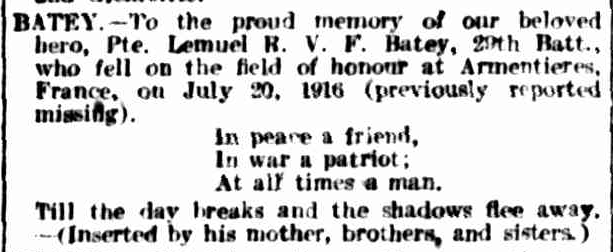
The family and their local community held a memorial service on 30 September 1917 for Lemuel who had been honorary secretary of the church for several years. The service opened with his favourite hymn, “Nearer My God to Thee”.
Seeking answers
While Laura’s communications with the Red Cross did not have success in finding definitive answers as to her brother’s fate, the information gathered by the Red Cross from fellow soldiers at least provided some clues as to what happened to Lemuel. It was a regular practice for the Red Cross to pass information gathered on to the families concerned so we assume it came to the attention of Lemuel’s mother and siblings.
From the evidence given, it seems highly probable that Lemuel died from wounds to his shoulder, and perhaps his legs. It is also probable that he was buried somewhere in no man’s land.
This website’s story of Lemuel’s began with the statement by Corporal Fred Webster where he stated that Lemuel was buried with 20 or 30 other soldiers - including eight from his own platoon - in a large grave near Pozieres. Corporal Webster and his brother William were present at the burial and he states that they were the only two survivors from Lem’s platoon. In addition to Webster’s evidence, the Red Cross gathered reports from other men of the 29th Battalion.
Pte Frank J BUCKLAND 380, A Company provided two separate statements, the first on 5 December 1916 and the second on 15 January 1917:
’At Fromelles on 19th July at about midnight, I saw Batey wounded slightly in the shoulder. I wanted to bind him up but he said he was all right. This was the last time I saw him. We had taken the third German trench; it was in the first trench that Batey was wounded. We eventually had to evacuate the trenches.’
'I saw him in the German front line on July 19, at Fleurbaix with a wound in the shoulder. He was working his way up the trench at the time, trying to get back to our lines. I knew he was missing afterwards, but know nothing further of him.’
413 Corporal William BRADEN 413, A Company provided a statement on 6 December 1916:
'The last seen of him was in the Fromelles attack of July 19th when he was left in No Man's Land with his shoulder shattered. Offered help, he replied: "Never mind me, I'll be all right, go on." He was not seen again.'
2092 Pte John H. MOORE 2092, A Company, also provided two statements, 6 December and 14 December 1916:
‘On the 20th July during the attack at Fromelles, Informant saw Batey wounded in the shoulder and both legs. It was between the German 1st and 2nd lines, and later we retired to our original position and Batey was, Informant believes, left. Informant added that Batey was a very fine fellow and one of the most popular men in the Coy.’
'On July 20th. 1916 at Fromelles Batey was badly wounded in the shoulder and legs. He was left near the second line of trenches before they returned to the original line.'
Like Laura and her family back in the war years, we continue to seek answers today. We are keen to find suitable DNA donors in the hope that that DNA might identify Lemuel as one of those unidentified soldiers buried in the Pheasant Wood cemetery at Fromelles. Can you help?
DNA is still being sought for family connections to
| Soldier | Lemuel Reginald Batey (1895-1916) Katandra, Victoria |
| Siblings | Martin, Thomas, Edward, Francis, Lilian, Lauristina, George, Isaac, Camelia |
| Parents | Thomas Place BATEY (1845-1902) and Eliza Ann FORD (1855-1921)of Katandra Vic |
| Grandparents | |||
| Paternal | Martin BATEY and Alice Place ROBSON arrived Victoria 1841 from Bishop Aukland Co Durham and had a family of twelve. | ||
| Maternal | Thomas FORD (1827-1906) b Chorley, Cheshire and Elizabeth BRACEGIRDLE (1787-1862) b. Chelford Cheshire. |
The Fromelles Association would love to hear from you

Contacts
(Contact: royce@fromelles.info or geoffrey@fromelles.info).
(Contact: army.uwc@defence.gov.au or phone 1800 019 090).
Donations
If you are able, please contribute to the upkeep of this resource.
(Contact: bill@fromelles.info ).
